XGC1¶
Background¶
XGC1 is a gyrokinetic Particle-In-Cell code for simulating plasma turbulence in magnetic confinement fusion devices. It self-consistently solves the kinetic evolution of the charged particle distribution and the electromagnetic fields. Lagrangian equation of motion is used for time advancing the particles, while conserving the mass, canonical angular momentum, and energy. The usual gyrokinetic Poisson equation is solved with the four-point averaging technique. In order to simulate the whole reactor geometry without mathematical difficulties at magnetic null points, XGC1 uses a cylindrical coordinate system for the particle motion and an unstructured mesh for the field solver. An electron sub-cycling scheme is used to accelerate ion-scale simulations.
XGC1 is written mostly in Fortran 90 with roughly 100 000 lines of code in the main branch. The PI of the XGC1 development team is Prof. CS Chang at PPPL and the team members in multiple universities and national labs. XGC1 has been selected as one of the main tools in the ECP project High-Fidelity Whole Device Modeling of Magnetically Confined Fusion Plasma. The code is version controlled under git and hosted in bitbucket. For access to the repository, please contact the main developers.
The XGC1 code has five main kernels:
- Particle Push
- Charge Deposition
- Particle Shift
- Collision Operator
- Field Solver
Performance on KNL¶
In production runs, up to 80% of the computing time in XGC1 is spent in the electron push routine. This is typical of gyrokinetic PIC codes, and is caused by the electron sub-cycling scheme. For each ion time step, a large number (typically around 50) electron time steps are made without charge deposition or field solve in between.
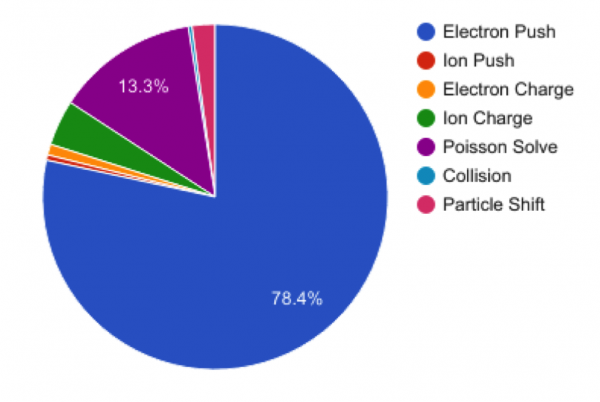
Figure 1. Time Spent in XGC1 Main Kernels in a 1024 Node Run on Cori KNL
Optimizations To Electron Push¶
The electron push algorithm consists of four main steps:
- Search for nearest 3 mesh nodes to the particle position & map to neighbor plane
- Interpolate fields from 6 mesh points to particle position
- Calculate force on particle from fields
- Push particle for time step dt
An electron push kernel pushe that can be ran separately from the main XGC1 code had been prepared by the XGC1 team. We profiled the pushe kernel heavily with VTune and Advisor and found that steps 1-3 were all roughly equally expensive. The summary reports are shown in the figure below.
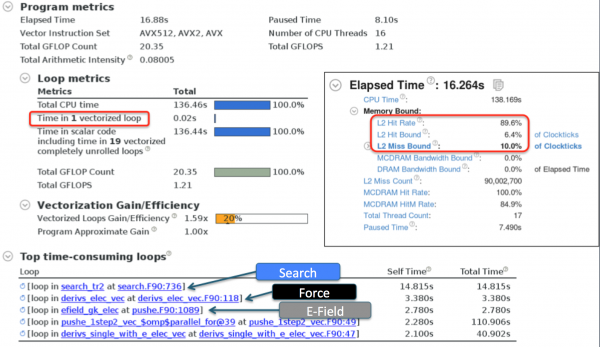
The main issues identified were
- no compiler auto-vectorization;
- poor hit rate in L2 cache.
Both issues called for a re-structuring of the code. In the original state the main routine loops over the sub-cycles and in each sub cycle loops over the electrons. Within the electron loop, long chains of subroutine calls are made with too small tripcounts to merit vectorization. Each particle typically touches the same data on the grid multiple times during the sub-cycling, but because all particles are processed per sub-cycle, the cache locality is lost.
We introduced cache blocking over the particles, and reversed the order of the time and particle loops to take improve the cache reuse. Then we moved the inner particle loop to the lowest subroutines, typically dealing with interpolation of data from the mesh. The re-structuring is illustrated in the figure below:
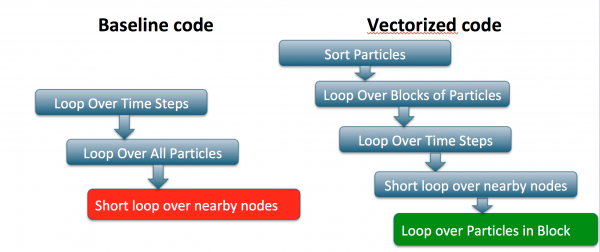
This structure allows both better cache re-use and compiler vectorization in some of the hot loops. The performance is limited by indirect memory access in the interpolation loops that does not vectorize well. The compiler has to generate gather/scatter instructions that incur large latency. This is a feature of particle codes that is hard to avoid completely. Although we sort particles and try to block over particle in the same part of the grid that touch the same data, unless we sort after every sub-cycle, which is too expensive, we can't guarantee that each particle in the block will touch the same grid data and therefore we have to access the grid on every sub-cycle.
To improve the memory access patterns, a re-ordering of the particle data structures was made. Originally the particle data was stored in two data structures that contain a total of 40 double precision numbers (and a few integers). These numbers include coordinate values, vector field values, field derivatives, and such. The original data structure was an Array of Structures (AoS). Such data structure can be beneficial for memory access when the structures are small and the whole structure is accessed in sequence. In XGC1, typically 3 values from the structure of 40 are accessed in sequence (for example, x,y,z components of the magnetic field). For this type of access, the AoS incurs large strides when looping over particles, which is what we want to do. We found improved performance with a Structure of Arrays (SoA) data structure, where looping over particles is unit strided, and the array size is tuned to fit in cache. To take advantage of the typical access to 3 consecutive values from the structure, we also introduced a compound data structure that can be described as SoSoA, where the x,y,z components form sub-structures in the main data structure.
The profiling summaries for the optimized code from Intel VTune and Advisor are shown in the figures below. We conclude that the vectorization has been improved to cover roughly 1/3 of the code base. The L2 cache hit rate is now close to 100%, and VTune actually flags L2 hit latency as the main bottleneck. If one looks closer at the memory access pattern analysis in Advisor, the main interpolation loops indeed contain gather/scatter instructions.
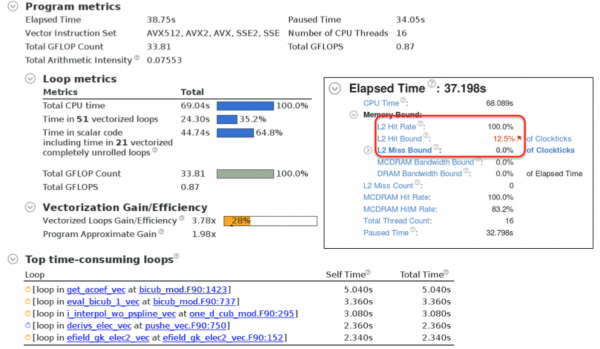

Charge Deposition Threading Optimization¶
Charge deposition in XGC1 is performed after every ion time step for both ions and electrons. Each MPI ranks deposits charge on the whole grid, dividing the work among its OpenMP threads. The ion charge is deposited in a 3-D array with the dimensions [number of grid nodes per toroidal plane, number of velocity space grid points, number of adjacent toroidal planes]. The number of adjacent toroidal planes is always 2. The velocity grid is required for the gyro-averaging routine and usually has 4 or 8 points. The total size of this array is therefore 8 - 16 x the size of the unstructured mesh, usually ~100k - 1M, totaling 1M - 10M elements. The electron charge is deposited without using a velocity space grid, which reduces the size of the array. In the initial implementation, a separate copy of the charge density array was allocated for each thread. Each thread would initialize it to 0 and deposit charge from a subset of particles to its own copy of the array. In the end a sum over all copies of the array would be stored on the master thread, but the reduction sum was done manually with a loop written in the code.
We found two problems in large-scale runs on Cori KNL.
- The initialization of 10M elements per thread
avx512_memsetfunction became extremely slow; - the manual reduction was not well optimized. Both the problems had the same cause: trying to do by hand something that is built into OpenMP.
To solve 1) and 2) we eliminated the allocation and initialization of separate copies for each thread. However, when all threads write to the same array, we have to make sure we don't create race conditions. We developed two solutions
- Declare the charge density array with
!$omp reduction(+:). Whenomp reductionis used, the variable becomes private to each thread within the parallel region and a sum over all threads is calculated at the end of the parallel region. This imitates what the code was doing before but the OpenMP runtime provides a much better optimized implementation. - Declare the charge density array
!$omp sharedand declare all updates to the array!$omp atomic.
The performance of optimizations 1 and 2 depend on the setup of the problem, especially the size of the unstructured mesh and the number of particles per thread. The OpenMP reduction operation incurs an overhead from creating private copies of the array at the beginning of the parallel region and calculating the sum over all threads at the end of the parallel region. This overhead depends on the size of the unstructured mesh. The OpenMP atomic update operation on the other hand incurs an overhead whenever two threads try to update the same memory location and the other thread has to wait, and potentially retrieve the value from the cache of another core before updating it. This overhead is fairly constant per particle (ie, a certain fraction of particles will cause a wait, regardless of the total number of particles), therefore increasing the number of particles increases the total overhead.
The charge deposition optimizations were tested with a 60 000 node unstructured mesh, on 16 compute nodes running 16 MPI ranks per node and 16 OpenMP threads per MPI rank. The number of particles per thread was varied between 10 000 and 400 000.
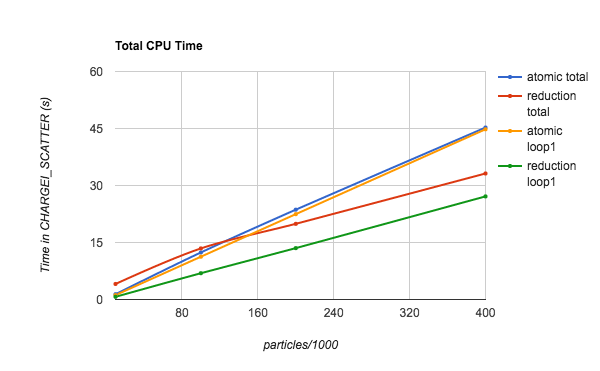
Figure 1. The time spent in Ion Charge Deposition Scatter routine, as a function of the number of particles per thread. Both the total time and the time inside the parallel region (loop1) are plotted for both atomic and reduction operations.
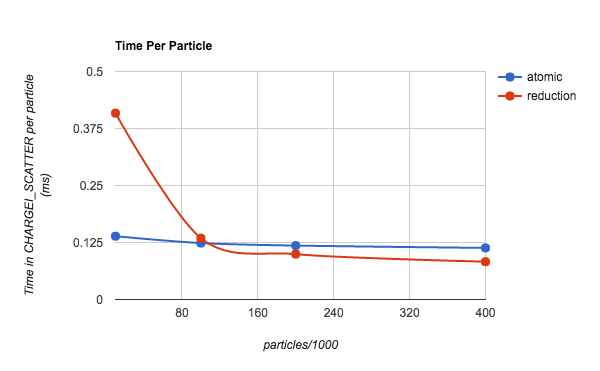
Figure 2. The time per particle in Ion Charge Deposition Scatter routine, as a function of number of particles per thread. Only total time is plotted for both atomic and reduction operations.
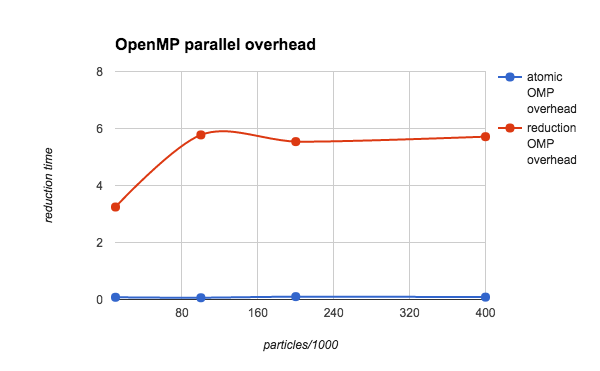
Figure 3. The overhead from the OpenMP parallel region (copying private variables and the reduction) for both atomic and reduction operations. The time plotted here is roughly equal to the difference between the total time and the loop1 time in Figure 1.
Strong Scaling¶
A strong scaling study on Cori KNL nodes up to full Cori scale (8196 nodes) shows good strong scaling for a large problem size.
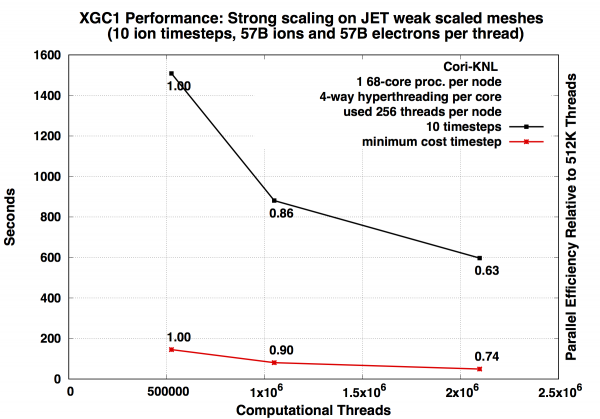
Weak Scaling¶
A weak scaling study was performed by scaling up to a large-size run on full Cori size. The parameters of the study are summarized in the table below:
| Compute Nodes | Threads | Grid Nodes Per Rank | Total Grid Nodes | Particles Per Thread | Total Particles (billions) |
|---|---|---|---|---|---|
| 128 | 32 768 | 117 | 3 750 | 55 000 | 1.8 |
| 256 | 65 536 | 117 | 7 500 | 55 000 | 3.6 |
| 512 | 131 072 | 117 | 15 000 | 55 000 | 7.2 |
| 1024 | 262 144 | 117 | 30 000 | 55 000 | 14.4 |
| 2048 | 524 288 | 117 | 60 000 | 55 000 | 28.8 |
| 4096 | 1 048 576 | 117 | 120 000 | 55 000 | 57.6 |
| 8192 | 2 098 176 | 117 | 240 000 | 55 000 | 115 |
The jobs were configured to run with 64 OpenMP threads per MPI rank and 4 MPI ranks per node, fully subscribing the available hyper-threads on the KNL nodes. The KNL nodes were used in quad,cache mode.
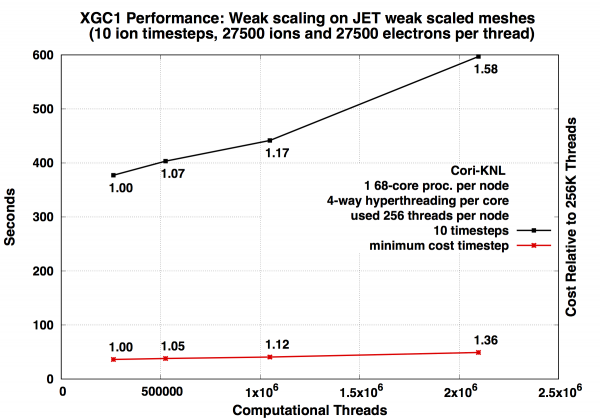
References¶
Koskela T., Deslippe J. (2017) Optimizing Fusion PIC Code Performance at Scale on Cori Phase Two. In: Kunkel J., Yokota R., Taufer M., Shalf J. (eds) High Performance Computing. ISC High Performance 2017. Lecture Notes in Computer Science, vol 10524. Springer, Cham https://doi.org/10.1007/978-3-319-67630-2_32
Koskela T., Raman K., Friesen B., Deslippe J. (2017) Fusion PIC Code Performance Analysis on The Cori KNL System. Cray User's Group Meeting 2017. https://cug.org/proceedings/cug2017_proceedings/includes/files/pap152s2-file1.pdf
Kurth T. et al. (2017) Analyzing Performance of Selected NESAP Applications on the Cori HPC System. In: Kunkel J., Yokota R., Taufer M., Shalf J. (eds) High Performance Computing. ISC High Performance 2017. Lecture Notes in Computer Science, vol 10524. Springer, Cham https://doi.org/10.1007/978-3-319-67630-2_25
Talk given at NERSC application readiness meeting on 02/14/2018 by T. Koskela (PDF)